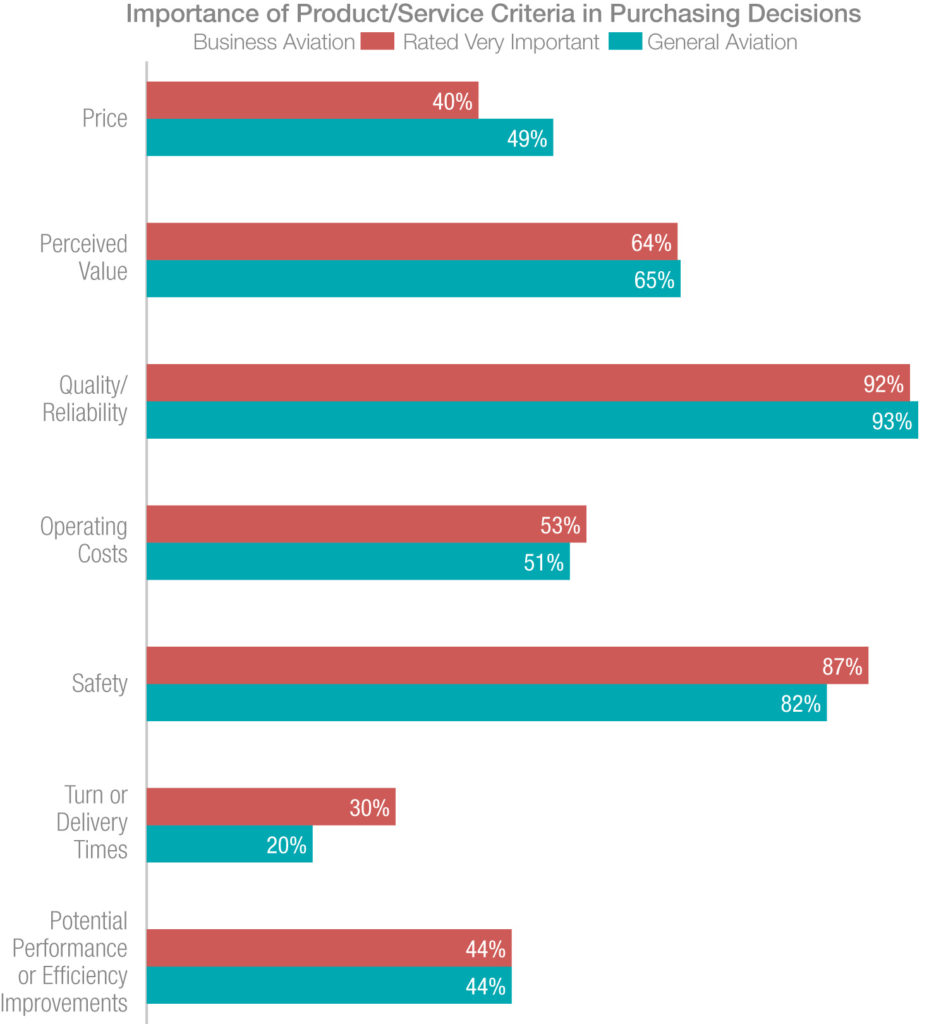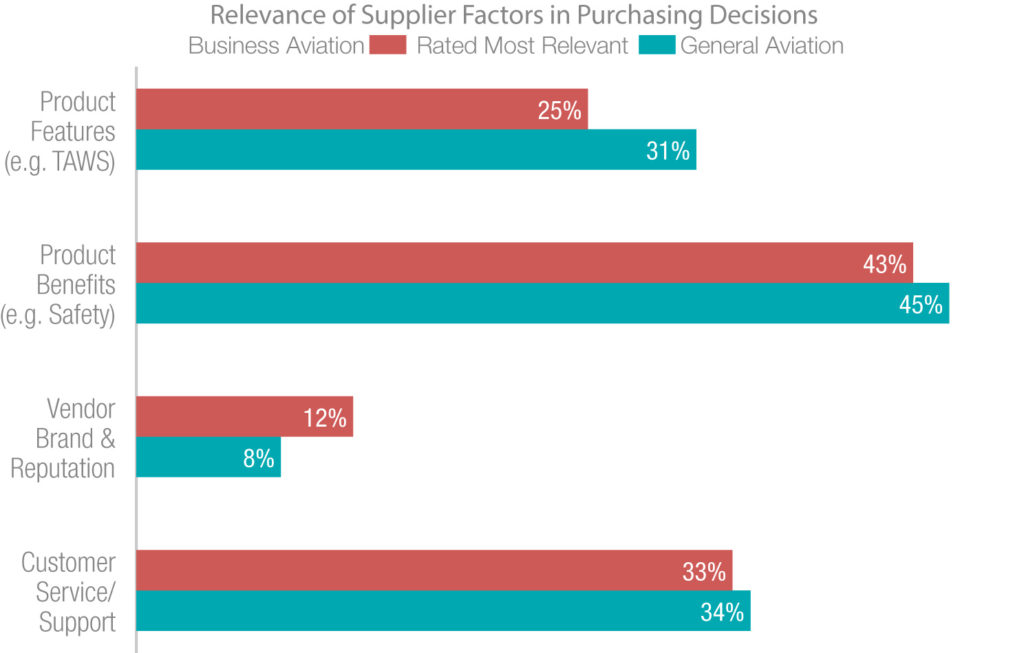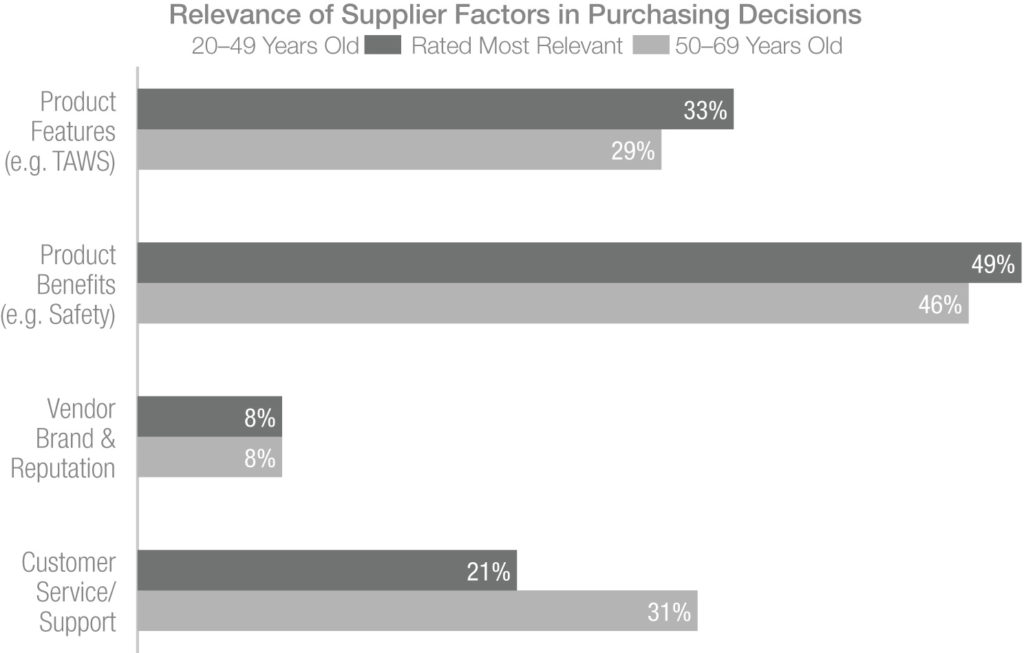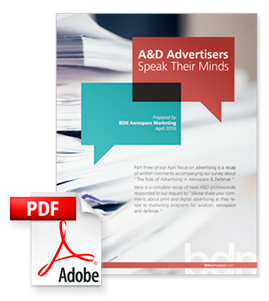Category: BDN
Audio: Lead Generation Case Study
This Marketing Flight Manual is downloadable audio content.
Is lead generation important to your business? This week, we sit down with Business Development Executive Ashley Cutler and VP of Client Services Lisa Sifuentes as they discuss their efforts on a recent lead generation campaign with host and Senior Designer Nick Markwardt. As you will hear, the results were nothing short of astounding.
Play this week’s session below or click here to download the MP3.

The full case study, including additional metrics and tips for improving your own lead generation efforts, will be available for download here on the Marketing Flight Manual next week.
[vc_separator type=”” size=”” icon=”plane”]
Lead Generation resources you might also be interested in:
How to Get the Aerospace Marketing Budget You Need
 New year. New opportunities. Same inadequate marketing budget.
New year. New opportunities. Same inadequate marketing budget.
Let’s face it, the budgeting process at too many aerospace and defense companies is flawed. Budgets may be dictated by people who don’t understand marketing…based on last year’s numbers instead of this year’s realities…or result from a last-minute fire drill because the boss wants numbers now.
Next year is going to be different. And it starts right here.
[vc_separator type=”” size=”” icon=”plane”]
Don’t Wait
Start mapping out your goals, strategy, plan and budget requirements now. Go to your boss well in advance of budget season with a buttoned-up, airtight business presentation that changes the conversation about the role, purpose and needs of a professional marketing organization. Elevate the discussion. Stop talking about outputs — you both should be focused on outcomes. Don’t spend time debating the merits of specific trade shows, advertising or other low-level tactics. They are simply a means to an end and should be left to the marketing team.
Actionable Idea: This marketing plan template is a good way to get started.
Have a Plan
Develop and present a plan that closely supports your organization’s business goals. Explain to your boss what you are recommending, and why, always linking back to expected outcomes. Show how marketing is a necessary investment — not a necessary evil — that is essential to business success.
Actionable Idea: Set the tone for an elevated discussion with an unexpected presentation format, like Prezi, or with a website or portal purpose-built and devoted to housing your proposed marketing program. Use the site to showcase your plan and offer it as a way for the boss to always have real-time digital access and visibility to marketing plans, activities and progress.
Use Data
In addition to a plan and business case, show the boss that your request is appropriate and supported by industry benchmarks. Brainrider reports that B2B marketing budgets as a percentage of total gross revenues remain steady at 2 percent, and other benchmarking sources show it’s closer to 5 percent. In our experience, aerospace businesses tend to spend less. Either way, the numbers need to be adjusted for new businesses, product launches, rebranding and other special circumstances.
Actionable Idea: Showing the boss that you are aware of best practices in budget allocation is also important, and referring to data bolsters your case.
Be Accountable
Establish and track three-to-five relevant Key Performance Indicators (KPIs) as agreed-on measures of success. Forget about vanity metrics. Impact Branding suggests five truly meaningful KPIs and explains how to calculate each one here.
Customer Lifetime Value – Understanding the value of a new customer can help you decide how much to spend on marketing.
Customer Acquisition Cost – Allocate your budget wisely by investing in the channels and tactics that have the lowest acquisition cost.
Sales Response Time – Customers are well on their way to making a decision before they ever contact you, so when they do reach out they are sales-ready. Don’t keep them waiting.
Inbound Links – Inbound links help SEO but also support brand awareness and authority.
Ratio of Website Leads to Marketing Qualified Leads – Too many unqualified leads waste precious resources but do little to drive results.
Actionable Idea: Post and maintain digital dashboards on your marketing website or portal.
Tell us about your budgeting process and how you get the resources you need. And, if you liked this post you may also enjoy our recent audio presentation. It provides actionable ideas for budget-friendly marketing.
Audio: Budget-Friendly Marketing
This week, BDN Aerospace Marketing is venturing into the world of downloadable audio content.
In this, our first audio installment, BDN founding partner Kyle Davis and VP of Client Services Lisa Sifuentes share some of their favorite ideas for getting the most out of a tight marketing budget. Senior Designer Nick Markwardt guides the discussion as we touch on topics ranging from developing an annual plan and leveraging digital tools, to identifying and challenging budget-sapping “sacred cows.” In just 15 content-filled minutes, we reveal that good marketing doesn’t have to be expensive marketing.
Play this week’s session below or click here to download the MP3.

Resources mentioned in the show:
5 Branding Myths that are Hurting Your Aerospace Business

Branding is an ongoing source of discussion and disagreement in aerospace marketing, according to our recent industry surveys.
While some say they spend a lot of time and effort building their brand, far too many say that investing in branding is a waste of time and money.
As we enter into a month-long examination of aerospace industry branding, we start by tackling these 5 myths that are holding us back from better branding, better marketing and better results.
Myth No. 1: Branding is a waste of money.
Really? Consider this.
Valued at $121.8 billion, Microsoft’s B2B brand is the most valuable in the world. Siemens, a company with strong interests in aerospace, ranks at No. 20 with a value of $12.4 billion. Read more here.
But there’s more. A McKinsey study of B2B brands shows that companies with brands that are perceived as strong generate a higher EBIT margin than others.
In fact, strong brands outperform weak brands by 20 percent. A Forbes article, “Why B-To-B Branding Matters More than You Think,” cited the example of pump manufacturer Gardner Denver, reporting that the company attributes 43 percent of its value to be goodwill and other intangible assets.
This is consistent with our experience and our research. In one engagement, our client research showed that although two direct competitors had virtually identical ratings for factors like product quality and reliability, respondents were twice as likely to buy from the one with a large, well established brand name. When all other factors were equal, the best brand won.
Myth No. 2: Branding is only for consumer companies and has no bearing on a customer’s decision-making process. People will buy from us if we provide good products and competitive prices.
We hear this a lot. But the Forbes article reports that B2B brands are actually more important than B2C brands because B2B purchases matter more. “Buy the wrong toothpaste, and you can always change brands when the tube runs out. Buy the wrong turbine and you could hurt your company’s earnings for years – and find yourself looking for another job.”
Trust is paramount in our industry, and is a critical factor in any B2B buying decision. But you can’t sell trust by telling people you are trustworthy in an ad or a brochure. They have to feel it — and that happens through a clear and consistent brand experience.
Myth No. 3: My brand is my logo and tagline.
Your logo (and tagline if you have one) is an incredibly important part of your brand, but it’s only one element. Logos serve as a kind of visual shorthand for your business to help customers immediately identify and recall who you are and what you do.
Branding is also not synonymous with marketing. Marketing certainly contributes to a brand, but like the logo example, it is one small part of a much larger whole.
Writing for the Tronvig Group, James Heaton defines branding as “the expression of the essential truth or value of an organization, product, or service. It is communication of characteristics, values, and attributes that clarify what this particular brand is and is not.”
Heaton nails it, especially when he says this. “A brand will help encourage someone to buy a product, and it directly supports whatever sales or marketing activities are in play, but the brand does not explicitly say, “buy me.” Instead, it says, “This is what I am. This is why I exist. If you agree, if you like me, you can buy me, support me, and recommend me to your friends.”
As we tell our clients, a solid brand and strategic marketing program won’t make the sale, but they will create an environment conducive to making the sale.
Myth No. 4: Branding is for big companies with big budgets.
Once upon a time this may have been true. Building an aerospace brand has traditionally relied largely, but not exclusively, on advertising.
But advertising is expensive and it can be challenging to show a return on the investment made. For those who aren’t in a position to advertise, social media is a great and affordable tool for defining and building your brand, all while interacting with your audience and giving them a feel for who you are.
At a time when many aerospace businesses look and sound alike, small companies, especially, can leverage branding to set themselves apart from competitors, get noticed and be remembered!
For more ideas and inspiration, see how several B2B businesses, including GE and Maersk Line, are successfully using social media to build their brands.
Myth No. 5: Brands appeal to emotional buyers. B2B buyers make rational decisions.
B2B buyers are people. And people have emotions. Marketo makes the case that because B2B buyers are overwhelmed by information they use heuristics (a simple and efficient emotional shorthand used in decision-making). In fact, “whether or not the buyer realizes it, the decision is often made long before the buying process is completed. When this happens, even subconsciously, much of the buying process ends up being an effort to justify the initial emotional decision. B2B marketers can and should tap into this by appealing to the emotional side of their prospects, as well as their rational side. This is where branding comes in.”
Does your business believe in branding? Do they invest in it? Why or why not?
If you like this article, you may also be interested in:
Trends and Challenges in Aerospace Marketing: ‘We Need More Support’
 Last week we brought you research data and insight about trends impacting aerospace and defense marketers.
Last week we brought you research data and insight about trends impacting aerospace and defense marketers.
This week we continue that theme with verbatim comments from more than 30 survey respondents who wrote about their experiences in aerospace marketing. Here are the challenges, opportunities and trends they shared.
Market Conditions and Budgets
“Our biggest challenge is volatility within the industries where we work, specifically petroleum exploration.”
“The downturn in defense and aerospace has management looking to decrease marketing expenditures.”
“A decline in sales is dramatically impacting marketing resources. I am hopeful that the industry will rebound over the next few years.”
“Larger companies have more influence and are moving the market away from our solutions.”
“We are challenged by collapsing markets due to the global economy.”
“It seems our business is very much influenced by politics and whatever the current budget constraints that are in play.”
“We have too much ground to cover and not enough people or time to adequately address.”
“Our primary challenge as a small aviation electronics manufacturer is developing marketing programs around a changing product line that is undergoing constant timeline and feature revisions due to limited staff. Deadlines keep getting pushed back and budgets reduced due to delays in getting product to market.”
“Lack of funding limits our team and our messaging approach.”
“Marketing requires a sizeable investment of cash.”
“Due to tough economic times, budgeting for all required needs of a company can be tough. We use as many free social media and website resources as possible to help reduce costs associated with marketing.”
“Too much spending is required for trade shows and events that never go away. There are more every year.”
Insights: Budgets and resources are clearly a concern for our industry. Last week’s survey results revealed widespread under-spending, and the verbatim comments are in line with that assessment. Respondents also voiced concerns about the state of the industry, citing declining market opportunities as a prime challenge. With downturns in the business aviation, rotorcraft and defense segments, this is a very real challenge that must be addressed. But why are so many companies cutting marketing when sales are down? It defies logic. Because just as food is the fuel that helps us remain healthy and thrive, marketing is the fuel that is essential for business success. Without it, our businesses will weaken, wither and die. If marketing is the engine that powers your business, is it really the area to cut corners or to settle for a makeshift solution?
Resource: This white paper has more information about how much companies should budget for marketing, with benchmarks and industry data you need now.
Targeted Marketing to Reach Decision Makers
“Getting in front of decision makers is a challenge. Everyone understands our business and how it may be used to leverage their efforts, but the decision makers are buried in white noise from everything else.”
“In my business, marketing means selling ideas to customers and obtaining funding for those ideas. They are not for public dissemination, so marketing is very selective and done on a one-on-one basis vs. broadcasting. As we gain ground in funded projects and create products for sale, marketing will become somewhat more traditional, but still very selective, and the objective targets will be contacted via personal measures.”
“It’s tough to break through the clutter of email and offers.”
“I see a lot of money being spent on non-productive initiatives. As a small niche consulting firm, we would only be served by targeted marketing to a few potential prospects.”
“It’s extremely difficult to get a foot in the door with the right people. Sending emails offering support and adding value with our quality products and services to try to get new customers is completely ineffective. We’ve hit a wall as far as generating new leads.”
Insights: Aerospace industry marketers are generally fortunate to have a clearly defined audience of potential customers and influencers. Being highly targeted in this way should make our jobs easier, right? Yet time and time again we hear from marketers who are frustrated with their inability to reach decision makers. If this is a challenge you face, we suggest that you start by questioning your diagnosis. Are you sure that you are not reaching the right people? Or is there a problem with the messaging? Is the delivery method wrong? What do your analytics tell you? An abundance of aerospace marketing is company-centric, focusing too much on what the company does, and too little on how it will make the customer’s life better. Get to the root cause of the problem and you’ll be one step closer to a real solution.
Resources: If your goal is to do business with OEMs, this blog, “The Truth About Marketing to Aerospace OEMs,” details six specific steps to connect with your target audience. Or, download this related infographic, “How to Gain Visibility with OEMs.” Are you working to generate more leads? Check out “Four Keys to Lead-Generation Success.”
Need for Measurement
“We are unable to measure return on investment effectively or directly.”
“On the general aviation side, finding ways to cost-effectively measure ROI and leads remains a challenge. The industry is specialized enough to warrant a more customized approach (software, etc.) but too small to really afford it, so a patchwork of systems is created.”
“Creating meaningful content, with enough depth and technical information to satisfy the customer, is a challenge. We also lack marketing team resources and the ability to justify ROI to the CFO.”
Insights: Measuring the impact of marketing is possible – it’s just not easy. Take advantage of the many resources and tools available to help you establish and build a process that will work for you and your company. And remember, calculating ROI is simply the cost of a sale subtracted from the profits on that sale, divided by the profit number (and expressed as a percentage).
Resources: While we do not endorse any single program or provider, explore these resources to learn more about how to measure your marketing effectiveness: Marketingprofs, Lenskold, Marketingmo, or Marketo.
Embracing New Approaches & Fresh Ideas
“Keeping up with social media is a challenge since it morphs easily into other avenues that may or may not be readily addressed.”
“Personal relationships and prior customers form the basis of our support. It’s tough to break the 30-year mold of “what we have done in the past” to get senior management buy-in on newer marketing trends and strategies. We also don’t have anyone with a formal marketing background to help us stay current and continually engage our market sector. We also don’t have a large budget for marketing. We are in the black hole of business development.”
“Most marketing efforts are run of the mill, with everyone using the same idea or concept.”
“People don’t think outside the box enough. A great deal of advertising and publication content is flat and lifeless.”
Insights: We often hear from aerospace marketers who feel their work — or that of their outside provider — has become stale. Many others say that they are overworked, overwhelmed and simply unable to keep up with the new tools and technologies that are revolutionizing our profession.
Resources: Get your marketing program back on track with inspiration from this fact-filled infographic, “12 Secrets to Marketing Success.” Do something different! From live chat to drones, here are 10 fresh ideas to breathe new life into a marketing program that has grown stale. Some businesses find that external support is a good fit for their needs; other times it’s not the best option. This white paper, “Is it Time to Hire an Outside Marketing Firm?” can help you find the approach that’s right for you.
Other Comments & Concerns
“Online tactics and properties are key to our marketing strategy, but using an old-fashioned direct approach (postcards) is also successful. We were staff-challenged last year, but have since staffed up. This allows us to focus on our biggest asset, our website, while also pursuing direct marketing. Supplying good content and imagery is always an issue with a smaller budget. Managing an integrated marketing program with many moving parts and deadlines is a challenge, and it’s hard to know whether a marketing management application will really help, or end up becoming the work. We have also been challenged measuring ROI for activities, but have determined that a contributory methodology is likely the best. We look at what activity contributed to a sale versus pegging a sale to one activity — something that is very difficult to do in B to B marketing.”
“Social media does not reach 59-65 year-old C-level executives.”
“Our major challenge is getting corporate approval for website redesign. The current site is ancient, has insufficient content, and is hard to navigate.”
“I see many smaller niche print and digital publications refusing to cover a newsworthy product launch just because the company is not an advertiser. We are finding that editorial is being driven a lot more by advertising sales input — at least for smaller market media.”
“Our real issue is how to be more efficient.”
“It’s hard to convince anyone that I’ve spoken to in aerospace that image, and how they present themselves, matters.”
“Building brand awareness for new or merged brands is always a challenge.”
What are your marketing challenges, issues and concerns? We’d love to hear from you and welcome all questions and comments!
7 Discouraging, Surprising, Yet Hopeful Truths About Modern Aerospace Marketing

BDN routinely uses research to understand, benchmark and report the trends and realities impacting the work we do as aerospace marketers.
In our most recent survey we asked aerospace marketers questions about their approach to budgeting and planning, goal-setting, goal accomplishment, their most effective tools and techniques, and levels of satisfaction with their company’s marketing performance.
We wondered, “Is there a correlation between those who plan and those who get results?” “Are some tactics consistently much more effective than others?” And, “Do budgets equate to higher perceived performance?”
It turns out that the answer is yes to all these questions, yet there is still much to be learned. Today we are providing a high-level summary of our findings with key takeaways and insights that shine a light (not always a flattering one) on our industry and our profession. This is ideal for those who want a quick read.
Anyone who would like more in-depth charts and findings may request the complete survey results here.
And remember, these results are suggestive, not scientific.
Key Insights & Takeaways
Finding: Regardless of their annual revenue, aerospace companies are still under-spending on marketing, with many high-revenue businesses spending just as little as their lower-revenue counterparts.
Insight: Shame on us. It’s hard to believe, but 20% of the $100,000,000 businesses have marketing budgets under $100,000. That’s an embarrassingly small .001%, and far below recommended spending and benchmarks for both B2B and our industry.
Takeaway: The budgeting process in larger companies sometimes defies logic, with decision-makers removed from the realities of individual functions. Verbatim comments tell us that more than a few companies are actually cutting marketing because industry conditions are bad. Huh? Marketers who work for an organization like this can either use data and measurement to become agents of change from within, remain ineffective, or run.
Finding: Most marketing budgets have stayed the same since 2015; a good number have increased; and very few have been cut.
Insight: Yes, this is positive news, but remember, budgets are still below accepted standards. Harvard Business Review generally suggests investing 3% of revenue in marketing, with adjustments made for specific scenarios.
Takeaway: Management probably believes marketing has everything it needs to be successful. After all, they have added or maintained existing budgets. But we can and must do better. If you are working with a limited budget, stop defaulting to old school tactics that can’t be measured — and when management wants you to do the same old, same old, explain that you can’t afford anything that fails to deliver ROI. Position yourself as the expert and start showing results to upper management that will justify the higher budget you know you need.
Finding: The majority of respondents say they do have and follow a marketing strategy and plan, yet there are striking differences here based on company revenue. More than 90% of the largest companies have a plan; less than 50% of the smallest do.
Insight: The survey shows that those with a strategy and plan are more satisfied with their company’s marketing performance than those without. It also shows that, as spending levels rise, so do levels of satisfaction with overall marketing performance.
Takeaway: A strategy, plan, adequate budget and measurement are the keys to your marketing success, regardless of company size. But if you are working with a smaller budget, strategy and planning become even more critical to ensure that every dollar spent is associated with an expected, measurable outcome.
Finding: Most respondents reported success in accomplishing key objectives. Improved brand awareness, improved customer engagement/relationships and increased sales were most frequently cited. Interestingly, 12% of those spending less than $100,000 report that they accomplished none of their objectives last year – no one spending $1 million or more said they accomplished nothing.
Insight: Regardless of budget, brand awareness and leads were cited as top successes. Because brand awareness is more difficult to measure it may be a more comfortable “metric” for some marketers. Challenge yourself to achieve more measurable objectives moving forward.
Takeaway: People are reporting success, and that’s good. Let’s just make sure those claims of success are based on data you can defend.
Finding: The most effective digital marketing efforts were websites (83%) and email marketing (79%). The highest marks for ineffective tactics were social media, blogs and online display ads, yet plenty of marketers also found them effective.
Insight: One, people are divided about what works in the digital realm. Also, while websites are recognized as effective, less than 50% say their SEO is effective.
Takeaway: We think the sheer volume of new and changing tools and options overwhelms many marketers. The first step to using the right digital tactics is understanding them – make time to get smart and use data to determine what is and is not working.
Finding: The most effective traditional marketing efforts were events and print advertising, yet print advertising also was most frequently called out as ineffective.
Insight: We continue to rely on old school tactics, perhaps to appease older, old school management, that are less likely to be measured.
Takeaway: If you are using events and print advertising (often the most expensive tactics) make sure you are tracking results. There are tools and techniques that make it possible to know if these approaches are working.
Finding: In 2016, marketers overwhelmingly say their No. 1 objective is increasing sales, followed by improved customer engagement, increased leads and improved brand awareness. Also, their No. 1 challenge is acquiring new customers, followed by lead generation and measuring ROI.
Insight: Hurray! Marketing exists to drive sales, and we are heartened to see folks acknowledging this connection.
Takeaway: Take a look at the relationship between marketing and sales in your organization. Are you using a CRM and marketing automation system to facilitate tracking, measurement and accountability? Are you working harmoniously toward a common goal? Or is there friction and finger pointing? Make mending and strengthening these relationships — adding in accountability for everyone — a priority for the good of the business.
Next up:
Keep reading next week for verbatim comments from more than 30 respondents who wrote to us about the challenges, opportunities and trends they are experiencing in their aerospace marketing work.
Don’t forget:
If you liked this blog post, you may also be interested in these free BDN resources:
- How to Develop a Marketing Communications Budget
- Budget Planning Checklist
- Marketing Planner
- 30 Days to Better Digital Marketing
10 insider secrets to getting your aerospace news published
 This week we are pleased to bring you a guest blog written by Jeremy Parkin, publisher of HeliHub.com. Jeremy has generously provided us with highly specific, actionable advice about what journalists do and not want from aerospace marketers in their PR outreach efforts, and his guidance is spot on. Read and follow these 10 tips and your media profile will improve — guaranteed.
This week we are pleased to bring you a guest blog written by Jeremy Parkin, publisher of HeliHub.com. Jeremy has generously provided us with highly specific, actionable advice about what journalists do and not want from aerospace marketers in their PR outreach efforts, and his guidance is spot on. Read and follow these 10 tips and your media profile will improve — guaranteed.
Editors are busy people, but you want your news item to get read and used. The more your stories, images and videos can be seen, the more your organisational profile will rise and be recognized compared to your competitors. Journalists could be out of their office, so these tips will help you reach people who may work for extended periods of time off a smart phone or tablet.
A key part of the process is to present the information in the most accessible way, and from my experience launching and building the world’s first helicopter industry news website, I hope these tips will guide you to better success in promoting your news. I also have a significant background in the IT industry, particularly social media, and I hope these insights assist in that arena, too.
- Document formats The text of your press release needs to be easily accessible by an editor. You want them to cut and paste quotes from your key people. We are much less likely to use a PDF press release and will prioritize a Word document. Better still, put the text of your press release in the body of an email like Airbus Helicopters does. Avoid sending press releases as attachments, and don’t send multiple languages of the same text in the same email – our automatic translation software gets very confused when Turbomeca (now Safran) send English and French in the body of the same email message. These rules apply irrespective of whether you send emails direct, or use an email marketing system such as MailChimp.
- Multiple stories If you are sending two stories, send them as separate emails, ideally a week or more apart, and ensure they are distinctly different. A few years back, Bell Helicopter took to issuing a new press release for every single country that approved a higher MTOW for the 429 model, in some cases countries where they needed lots of optimism to even sell an aircraft. That soon became a “Boy Who Cried Wolf” situation and we exercised the [Del] button.
- How many images? Every press release needs an image – the saying, “A picture is worth 1,000 words” still holds true. Some say multiple images mean bigger (and slower) emails which could be quarantined by an email server, so consider supplying images via a link to a public-access folder on Dropbox.com like MD Helicopters do.
- Image File Format As HeliHub.com is entirely online, we prefer JPG. Media outlets that encumber themselves with hard copy issues may prefer PNG but will still be able to handle JPG. Images embedded into a PDF are ignored as too difficult to extract, even if it is technically possible.
- Image Size To present your image at a quality level which can be used, the minimum dimension should be 2000 pixels. With many smartphones capable of taking images or 3-4000 pixels, there is no excuse. Over half the images we receive are 1000 pixels across or less, and we ignore them. Be careful using a wire service. as some of them restrict image size and force the reader to sign up to something to get full-size images — the chances they will sign up are low.
- Presenting the subject in an Image Flying means wings or rotor blades, and these make for landscape images (wider than height). But the editor may have a portrait (taller than width) gap to fill. Leave “editing space” around the subject. At HeliHub.com we post two news-related images to Instagram every weekday, and that usually means square images. We also change our Twitter header image weekly – and that needs an image three times wider than its height.
- Lighting and weather We ignore dreary photos unless the subject is really important. Improve your images using free software such as GIMP. Very recently the image of the third AW609 tiltrotor prototype needed editing time as it looked like it was taken in a rainstorm.
- Corporate image bank Sometimes an editor will prefer to use your corporate logo, and you should have these available on (or from) your website, along with head shots of key people in your organisation. Consider using a free service like OpenBrand.com to host these, like Helipaddy does.
- Video format/location Press release video is still rare, but the click-through to a video online is remarkably high, so the cost may be worth the effort, even if the video is less than 60 seconds long. Minimum format is HD these days, and some in 4K. Only a few aviation organisations are using 360-degree videos, but this will be the way ahead for aircraft interiors or to show details of an equipment installation. Do not save videos on your own website, but instead on YouTube, Vimeo or Wistia so they can then be embedded easily into a story online. The vicarious benefit is the extra views from the search traffic of those sites – remember, YouTube is the world’s second biggest search engine.
- Compressed file formats Do not submit ZIP files; they are too much hassle. People who ZIP a JPG file are demonstrating that they don’t know that JPG format is already a compressed file format.
Interested in more information about working with the aerospace and defense news media? BDN has compiled a complete PR toolkit full of tools and tips to improve your skills and your results. Tons of other free aerospace marketing resources are also available for download. View the entire library here.
Decision-making factors in the aviation buying process
The May 10 Flight Manual focused on understanding the characteristics of purchasing decision makers within the business aviation (BA) and general aviation (GA) markets.
This week we dig deeper still to gain insight into the product and supplier factors that most influence their buying decisions. This goes to the heart of what buyers value most, so it’s directly relevant to those who market and sell to these audiences.
Looking at responses by both age and market we learned that, with a few exceptions, buyers tend to value the same things regardless of age or segment.
This is a somewhat high-level generalization, and we will highlight points of difference, but there are clear trends and preferences that apply across the board. It’s clear that people in these markets are more similar than they are different. Let’s take a closer look.
We asked respondents to rank the importance of various product and service criteria in their purchasing decision-making process. These criteria included price, perceived value, quality/reliability, operating costs, safety, turn/delivery times, and potential performance or efficiency improvements.

Both market segments are most concerned with quality and reliability, closely followed by safety, which was even more important to business aviation respondents.
While price is more important to GA, it is not the most important factor. In fact, it is similar in importance to efficiency improvements, and both are trailed by turn/delivery times, which matter more to BA than GA.
Moving on to look at the responses by age, we see that older and younger respondents generally value the same things.

Again, quality/reliability is first (and valued even more by older audiences) and safety is a close second. Perceived value is third, followed by operating costs and then price, which ranks much lower in importance overall. Potential efficiency improvements trail closely behind price, and turn/delivery times rank last, though they are slightly more important to older respondents.
Overall, people want the product to keep working, operate safely, represent a good value, and without costing a lot to operate — if they have to wait to get all of this, they will wait.
Based on this information, marketers should work to quantify and communicate the quality, reliability, safety and operating cost advantages of their products relative to their competition. Don’t make broad claims – use credible data and be specific to establish a clear competitive edge while shaping an overall perception of value.
When considering supplier-related factors such as product features, product benefits, vendor brand/reputation and customer service/support, it’s again evident that there are few differences between BA and GA.

Product benefits, such as safety, rule as most relevant to purchasing decisions, followed by customer service and support.
Ironically, we see that many aviation marketers focus heavily on product features and company-centric messages — yet these are much less important to their buyers.
These results tell us that aviation marketers who focus on what their customers really care about, and do it in a way that clearly and credibly distinguishes them from other providers, will win every time.
Looking at respondents by age, product benefits are still of top importance, and are even more important to younger buyers. Everyone values product features next, followed by customer service/support (which is substantially more important to those over 50).
Vendor brand/reputation ranks dead last, once again validating that buyers are benefit-oriented.

One could argue that a good brand is a shortcut to many of the features and factors that are preferred by respondents, but if we take them at their word, this survey sends a clear message to marketers about how to fine tune their marketing objectives, investments and messages for maximum effectiveness.
Coming up next week – from websites and data sheets to sales reps and dealers — find out what information sources are most influential in the purchasing process — and how those sources vary by market and age.
To further improve and approach your marketing in a more strategic fashion, download this easy-to-use marketing planner. It’s one of the most popular resources we offer.
Aerospace Advertising: What We Learned
When it comes to advertising, there’s one thing we can all agree on — things are changing.
Our month-long look at advertising was filtered through the lens of aerospace marketing professionals who shared their thoughts, experiences and insightful comments.
There were no true eureka moments — some findings were predictable and many a bit surprising — but we did learn a lot and uncovered several valuable takeaways.

While the survey shows that print is still important, the comments add some revealing caveats. Some marketers support print but characterize it as somewhat of a “necessary evil,” acknowledging that it is “unaccountable, expensive and slow,” yet driven by the belief that it is still necessary to reach older decision-makers.
Digital is valued because it is “trackable, targeted, and interactive,” and we are encouraged that marketers value measurement. Respondents are increasing their digital spending and most agree that digital advertising will ultimately displace print. The only real question is when it will happen. The cost difference between print and digital was mentioned quite frequently — BDN predicts that gap will close. As digital demand increases, prices will, too.
The comments make it clear that for the time being, print and digital are both important. As one respondent said, “an integrated strategy involving digital and traditional communications works best,” and this is a position BDN generally agrees with.
With clear goals and a smart strategy, the correct mix of tactics is generally quite clear, and for us, this is the key takeaway. Start with a sound strategy and the tactics will take care of themselves. This complete marketing plan template — customized for aerospace and defense — can help.
To see complete survey results, click here. To view marketers’ preferred publications, click here. And to read respondent comments, click here.
Don’t forget — this listing of 300+ A&D-specific media is a useful tool for advertisers. Download yours here.
Advertisers Speak Their Minds

Part three of our April focus on advertising is a recap of written comments accompanying our survey about “The Role of Advertising in Aerospace & Defense.” The majority of respondents provided written comments. An array of 20 representative remarks, some edited for space and grammar, are included here. To see what your fellow advertisers had to say, read on.
Now, if you don’t want to miss a single comment (and believe us, you don’t), you can download an expanded written summary of what 75 marketing pros really think about A&D advertising.
Meanwhile, here is a recap of how industry marketing professionals responded to our request to “please share your comments about print and digital advertising as they relate to marketing programs for aviation, aerospace and defense.”
We hope you find it as interesting and enlightening as we did.
‘Print is Dead’
“Digital is the way to go. Print is dead. It is old news before it is even published and mailed. Websites that engage the customer base and apps that provide utility with advertisements are a gold mine for us.”
“Targeting options in digital advertising offer much more bang for the buck than traditional print advertising options. I received my new AC-U-KWICK today and promptly threw it in the trash.”
“Print media has become outdated and hard to justify. Digital media is more trackable, targeted and interactive.”
“As a small company trying to displace the big boys, we have our best success with sales letters and road trips. Our limited print ads have yielded zero sales. We strongly feel that traditional print ads (blue sky, aircraft, product shots) do not help a small company break through. But we also strongly feel that a non-traditional campaign combining multiple outlets could. We believe that non-traditional print ads will be more and more effective as our prospects replace their old school vanguards with younger staff. So, we are focusing hard on how to make a non-traditional approach work.”
“Flight International, Aviation Week and other high dollar placements are getting the axe in favor of a more diverse and digital-centric strategy.”
‘A Break from the Digital Onslaught’
“Print has sustainability and is ideal for increasing image and brand awareness.”
“The current generation of decision-makers still relies on print for in-depth reading and information. Digital is fine for transitory news, but not for critical study.”
“There is too much digital advertising through social media and emails, so I ignore it. But with print I take my time and read through the entire magazine looking for information that may help my business. It provides a break from the digital onslaught.”
“Digital advertising is still not as effective as print. There are still too many old school decision makers who are not technically savvy.”
“Print is still the way to communicate to C-suite execs.”
‘We Need Both’
“In today’s market, print and digital advertising must work hand-in-hand in the marketing mix. Online presence reinforces the branding efforts through traditional print media and gives a valuable sense of immediacy to the messages.”
“An integrated strategy involving digital and traditional communications works best. The publications still have influence, and working with them benefits our company.”
“While I still focus primarily on print advertising, I usually look for a digital add-on. This could be a digital copy of the magazine with hot links to advertising, or a banner ad that is included as part of my buy.”
“Print is still a necessary evil, but digital brings much more value.”
“When your marketing challenge is establishing brand awareness, print advertising tied to measurable digital landing pages is still a good investment. For the selling of an established product or service, there are more effective channels.”
‘Editorial Still Beats Advertising’
”The industry as a whole seems focused on placements to say they were in a magazine rather than executing a real strategy.”
“Editorial, whether print or digital, still beats all advertising. Print, when distributed at high-profile industry conferences or trade shows, is effective. Ads in daily or weekly newsletters are also effective. Digital ads and digital directories are my least favorite — there is so much noise on web pages that they go unnoticed, and most of the time they are annoying.”
“For our company, it seems that when new clients find us it always start with a Google search.”
“Advertising helps promote our brand, but direct mailers and other activities engaging customer prospects are most effective in generating/closing sales.”
“Print is unaccountable, expensive, slow and perfect for the bathroom or La-Z-Boy recliner. Digital means fast feedback, video demos, click-through tracking.”
Don’t forget — this listing of 300+ A&D-specific media is a useful tool for advertisers. Download yours here.
Read Additional Insights
For a PDF document with the complete, must-read comments, click the image and don’t forget, we welcome your feedback — so tell us what you think!
